Fall Training
August 5-7, 2025
Divots Conference Center
4200 W Norfolk Ave,
Norfolk, NE 68701
|
Nebraska Noxious Weeds
You Are Required To Control Noxious Weeds On Your Property
Pursuant to the Noxious Weed Control Act, section 2-955, subsection 1(a), to every person who
owns or controls land in Nebraska, that noxious weeds being grown, or growing on, such land shall be controlled
at such frequency as to prevent establishment, provide eradication, or reduce further propagation or dissemination
of such weeds.
|
|
|
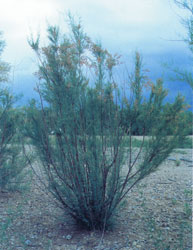
|
Saltcedar |
|
Saltcedar (Tamarix spp.) have long tap roots that allow them to intercept deep water tables and interfere with natural
aquatic systems. Saltcedar disrupts the structure and stability of native plant communities and
degrades native wildlife habitat by outcompeting and replacing native plant species, monopolizing
limited sources of moisture. Although it provides some shelter, the foliage and flowers of saltcedar
provide little food value for native wildlife species that depend on nutrient-rich native plant
resources.
More |
|
|
|
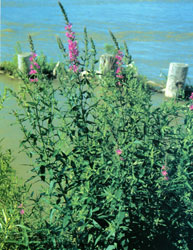
|
Purple Loosestrife |
|
Purple loosestrife (Lythrum salicaria L.) adapts readily to natural and disturbed wetlands. As it establishes and expands,
it outcompetes and replaces native grasses, sedges, and other flowering plants that provide a higher quality
source of nutrition for wildlife. The highly invasive nature of purple loosestrife allows it to form dense,
homogeneous stands that restrict native wetland plant species, including some federally endangered orchids,
and reduce habitat for waterfowl.
More |
|
|
|
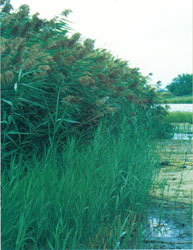
|
Phragmites |
|
Once introduced Phragmites (Phragmites australis) invades a site it quickly can take over, crowding out native plants, altering
wildlife habitat, and becoming a monoculture very quickly. Phragmites can spread both by seed dispersal
and by vegetative spread via fragments of rhizomes that break off and are transported elsewhere. New
populations of the introduced type may appear sparse for the first few years of growth but due to the
plant’s rapid growth rate, they will typically form a pure stand that chokes out other vegetation very
quickly.
More |
|
|
|
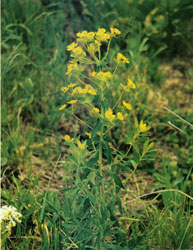
|
Leafy Spurge |
|
Leafy spurge (Euphorbia esula L.) displaces native vegetation in prairie habitats and fields through shading and by usurping
available water and nutrients and through plant toxins that prevent the growth of other plants underneath
it. Leafy spurge is an aggressive invader and, once present, can completely overtake large areas of open land.
More |
|
|
|
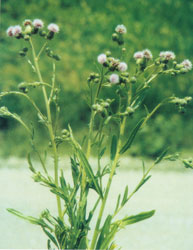
|
Canada Thistle |
|
Canada Thistle (Cirsium arvense L.) is declared a "noxious weed" throughout the U.S. and has long been recognized as a major
agricultural pest, costing tens of millions of dollars in direct crop losses annually and additional
millions costs for control. Only recently have the harmful impacts of Canada thistle to native species
and natural ecosystems received notable attention.
More |
|
|
|
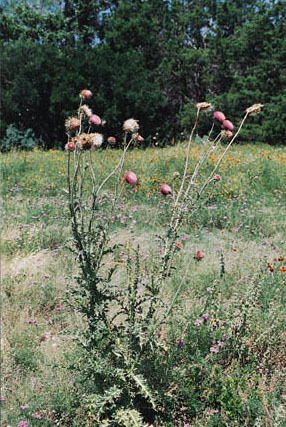
|
Musk Thistle |
|
Musk Thistle (Carduus nutans L.) is an aggressive, biennial herb with showy red-purple flowers and painful spiny stems and
leaves. Each plant may produce thousands of straw-colored seeds adorned with plume-like bristles.
More |
|
|
|
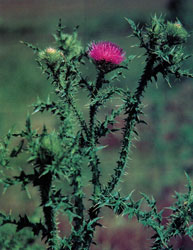
|
Plumeless Thistle |
|
Plumeless Thistle (Carduus acanthoides) is an aggressive weed and is similer to the closely related Musk Thistle. Plumeless
Thistle is a noxious weed in many states. It rarely flowers during its first year of growth.
More |
|
|
|
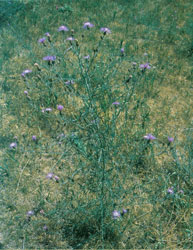
|
Spotted and Diffuse Knapweed |
|
Spotted Knapweed (Centaurea stoebe) and Diffuse Knapweed (Centaurea diffusa) are closely related and are noxious in several states. Diffuse Knapweed bracts
are divided like teeth of a comb and have a distinct terminal spine. Spotted Knapweed lacks this terminal spine.
More |
|
|
|
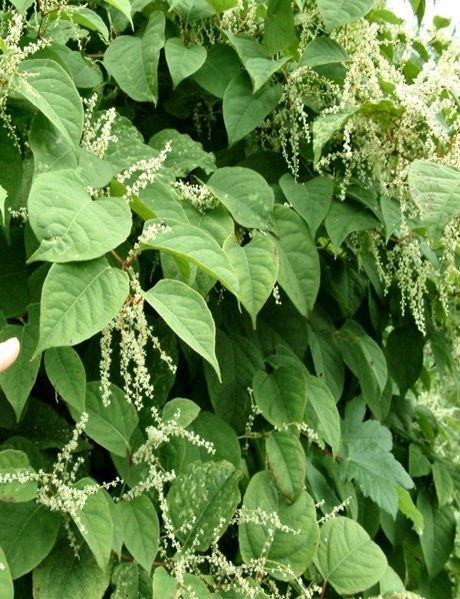
|
Japanese Knotweed |
|
Japanese Knotweed (Fallopia japonica), Giant Knotweed (Fallopia sachalinensis) and their hybrid Bohemian Knotweed (Fallopia bohemica)
and all cultivars and hybrids threaten open and riparian areas
where it spreads rapidly and forms dense near monoculture stands. It dramatically reduces species diversity and
alters habitat for wildlife. In raparian habitats F. japonica may also increase the risk of flooding and river
bank erosion as it establishes monospecific stand that die back in the winter leaving banks exposed. Prolific rhizome
and shoot growth can damage foundations, walls, pavements, drainage works, and flood prevention structures.
More
|
|
|
|
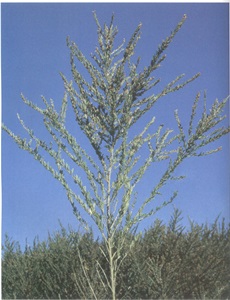
|
Sericea Lespedeza |
|
Sericea lespedeza (Lespedeza cuneata) is a long-lived perennial forb that grows well in grasslands, pastures,
along roadsides, drainage areas, fencerows and other disturbed areas. Sericea lespedeza is an extremely aggressive
invader of open areas. Dense monocultures of thickets are formed due to its ability to sprout from root crowns.
Established sericea lespedeza plants will reduce or eliminate competing vegetation and restrict the amount of light
reaching other plants. It readily escapes from cultivation into native grasslands and agricultural areas, and can
seriously impact pastures and natural areas.
More
|
|
Photos courtesy of the Weeds of the Great Plains |
|
County Added Weeds |
Nebraska Watchlist Weeds |
|